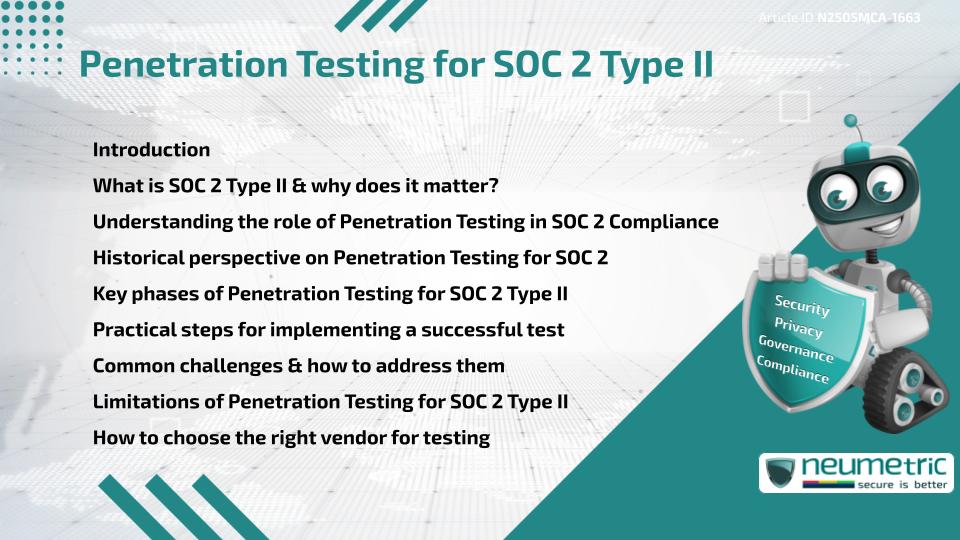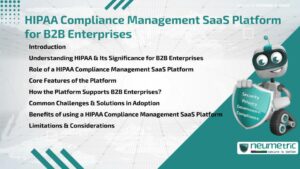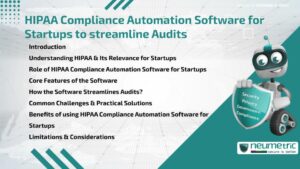Table of Contents
ToggleIntroduction
SOC 2 Type II Compliance is a benchmark for managing Customer Data based on Trust Service Criteria. Among its many requirements, Penetration Testing plays a vital role in ensuring that an Organisation’s systems are secure from malicious actors. This article unpacks the purpose, process & value of Penetration Testing for SOC 2 Type II in a way that’s straightforward & engaging.
What is SOC 2 Type II & why does it matter?
SOC 2, created by the American Institute of Certified Public Accountants [AICPA], is a Standard for managing data based on five trust service principles: security, availability, processing integrity, confidentiality & Privacy. Type II specifically examines the operating effectiveness of controls over a period, often six (6) to twelve (12) months.
Unlike SOC 2 Type I, which reviews controls at a point in time, Type II provides a deeper level of assurance. This makes it highly valued by clients & partners who want evidence of ongoing Data Protection. Penetration Testing for SOC 2 Type II helps to identify Vulnerabilities that automated tools might miss.
Understanding the role of Penetration Testing in SOC 2 Compliance
Penetration Testing is a simulated cyberattack performed to uncover potential weaknesses. For SOC 2 Type II, it’s a proactive way to validate whether Security Controls are working effectively over time. While the Standard does not mandate Penetration Testing explicitly, auditors often expect evidence that Vulnerabilities are regularly identified & mitigated.
According to the Cloud Security Alliance, Organisations that conduct regular Penetration Testing are more resilient to Threats & show stronger Compliance with frameworks like SOC 2 Type II.
Historical perspective on Penetration Testing for SOC 2
Historically, Penetration Testing emerged in the early 1990s as a part of ethical hacking. At first, it was limited to military & Government sectors. Over time, with rising Cybersecurity Risks, it became a best practice across industries. For SOC 2 Compliance, Penetration Testing gained traction as companies began facing data breaches despite having documented controls.
Today, Penetration Testing for SOC 2 Type II is seen as essential for maintaining security posture & protecting Sensitive Data. It reflects a shift from reactive to preventive security.
Key phases of Penetration Testing for SOC 2 Type II
Effective Penetration Testing for SOC 2 Type II typically follows five (5) key stages:
- Planning & reconnaissance: Understanding the scope, identifying assets & setting goals.
- Scanning: Mapping out attack surfaces & entry points.
- Gaining access: Attempting to exploit Vulnerabilities.
- Maintaining access: Checking if attackers can stay undetected.
- Analysis & reporting: Documenting findings, Risk levels & remediation steps.
Each stage is critical. Missed steps can lead to incomplete assessments that fail to satisfy auditors or protect data effectively.
Practical steps for implementing a successful test
Start by defining the scope—whether it covers internal systems, external interfaces or cloud environments. Next, schedule the test to avoid business disruptions. Use both automated tools & manual techniques for a comprehensive approach.
Involve Stakeholders from IT, legal & Compliance. Finally, use a reputable third party to ensure independence & credibility. According to OWASP, using qualified testers reduces the chance of oversight or conflict of interest.
Common challenges & how to address them
Organisations often struggle with timing, scope creep & interpreting test results. Poor planning can lead to missed Vulnerabilities. Ambiguous goals can cause confusion between testers & internal teams.
To address these issues:
- Create a clear testing schedule
- Define responsibilities upfront
- Translate findings into business terms for executive understanding
The SANS Institute offers guidance on how to integrate Penetration Testing into Compliance workflows effectively.
Limitations of Penetration Testing for SOC 2 Type II
While valuable, Penetration Testing is not foolproof. It provides a snapshot in time, not a guarantee of ongoing protection. Attackers may exploit new Vulnerabilities after the test concludes.
Additionally, if tests are too narrow, they may not reflect real-world Threats. This is why combining Penetration Testing for SOC 2 Type II with Continuous Monitoring & Vulnerability scanning is considered a better strategy.
How to choose the right vendor for testing
Choosing the right partner is crucial. Look for vendors with experience in SOC 2 Type II environments. They should understand Compliance nuances & offer both manual & automated testing options.
A strong vendor will also help interpret the results & offer actionable remediation steps, not just a technical dump.
Conclusion
Penetration Testing is not just a checkbox for SOC 2 Type II Compliance—it’s a strategic activity that reveals real Risks before attackers do. While not explicitly mandated, its presence in your security program demonstrates a proactive stance that auditors & clients both value. When properly scoped, executed & followed up, Penetration Testing adds depth to your security assurance & supports the integrity of your Trust Service Criteria. As Threats evolve, integrating regular testing with Continuous Monitoring becomes the best path to resilience & long-term Compliance.
Takeaways
- SOC 2 Type II validates the long-term effectiveness of Security Controls
- Penetration Testing strengthens this validation by identifying real-world Risks
- Planning, execution & reporting must be thorough & scoped correctly
- Limitations exist, but can be offset with Continuous Monitoring
- A qualified vendor enhances the credibility & depth of the test
FAQ
What is the difference between Vulnerability scanning & Penetration Testing for SOC 2 Type II?
Vulnerability scanning is automated & identifies known issues, while Penetration Testing simulates real attacks to uncover hidden or complex Vulnerabilities.
Is Penetration Testing mandatory for SOC 2 Type II Compliance?
It is not mandatory, but highly recommended. Most auditors expect to see evidence of Penetration Testing during SOC 2 Type II assessments.
How often should Penetration Testing be performed?
At least once a year or after major system changes. More frequent tests may be needed for high-Risk environments.
Can internal teams conduct Penetration Testing for SOC 2 Type II?
They can, but external vendors are preferred for objectivity & expertise. Independent tests also carry more weight with auditors.
What kind of systems should be included in the test scope?
Include external-facing assets, internal systems, cloud services & any Third Party integrations handling Sensitive Data.
How should we handle findings from the test?
Findings should be prioritized by Risk, documented & remediated promptly. Action plans must be part of the final SOC 2 Type II report.
Does Penetration Testing for SOC 2 Type II cover social engineering?
Sometimes. It depends on the scope. Including social engineering can reveal Risks from phishing or poor User awareness.
Can Penetration Testing be done remotely?
Yes. Many vendors offer remote testing using secure methods. On-site testing may be required for specific environments.
Should Penetration Testing be repeated after remediation?
Yes. Retesting ensures Vulnerabilities were fixed & systems are now secure, which supports your SOC 2 Type II evidence.
Need help?
Neumetric provides organisations the necessary help to achieve their Cybersecurity, Compliance, Governance, Privacy, Certifications & Pentesting goals.
Organisations & Businesses, specifically those which provide SaaS & AI Solutions, usually need a Cybersecurity Partner for meeting & maintaining the ongoing Security & Privacy needs & requirements of their Clients & Customers.
SOC 2, ISO 27001, ISO 42001, NIST, HIPAA, HECVAT, EU GDPR are some of the Frameworks that are served by Fusion – a centralised, automated, AI-enabled SaaS Solution created & managed by Neumetric.
Reach out to us!





